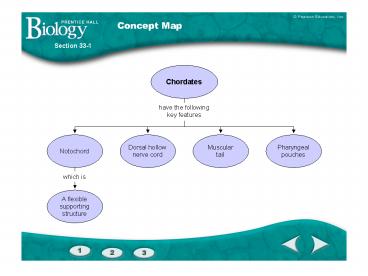Concept Map PowerPoint PPT Presentation
1 / 19
Title: Concept Map
1
Concept Map
2
Figure 332 A Cladogram of Chordates
Section 33-1
3
Body Temperature (C)
Environmental Temperature (C)
4
Comparing Functions of Chordates
Respiration Circulation Excretion Response
Gills and diffusion No true chambers Gills
andgill slits Simple mass of nerve cells
Non- vertebrate Chordates Gills and diffusion No
true chambers Gills andgill slits Simple mass
of nerve cells
Gills/air sacs Single loop 2
chambers Kidney andgills Cephalization small
cerebrum
Simple lungs and skin Double loop 3
chambers Kidney andgills Cephalization small
cerebrum
Lungs Double loop 3 chambers Kidney Cephali
zation small cerebrum
Lungs (tubes and air sacs one-way
flow) Double loop 4 chambers Kidney Cephalizatio
n large cerebrum
Lungs (alveoli) Double loop 4
chambers Kidney Cephalization large cerebrum
Birds
Function
Fishes
Amphibians (adult)
Reptiles
Mammals
5
Comparing Functions of Chordates
Movement Reproduction TemperatureContr
ol
Muscles,no bones External
fertilization Ectothermic
Muscles on either side of backbone External
fertilization Ectothermic
Limbs point directly toward ground muscles
and ligaments Internal fertilization shelled
egg Ectothermic
Upper limbs are wings 2 feet muscles and
ligaments Internal fertilization shelled
egg Endothermic
2 or 4 legs walk with legs straight under
them muscles and ligaments Internal
fertilization and development Endothermic
Birds
Function
Non- vertebrate Chordates
Fishes
Amphibians (adult)
Reptiles
Mammals
6
Form and Function in Vertebrates
7
Questions
- What relationship exists between the type of
circulatory pathway and the number of heart
chambers? - Organisms with a 2-chambered heart have a
single-loop and organisms with 3 or 4 chambered
hearts have a double-loop
8
- What is the relationship between the habitat of
an organism and the structures used for gas
exchange? - Aquatic organisms use gills and terrestrial
organisms use lungs.
9
- How does each type of nitrogenous waste excreted
relate to the type of excretory structure in each
group. - Ammonia is excreted by organisms that use gills
uric acid and urea is excreted by organisms that
use kidneys
10
Reproduction
11
Questions
- What relationship exists between an organisms
habitat and its method of fertilization? - In water, fertilization is external. On land,
fertilization is internal.
12
- How does the number of eggs produced relate to
the method of fertilization? - External fertilization requires many eggs, while
internal fertilization produces fewer eggs.
13
- The type of fertilization and the number of eggs
produced often indicate the amount of parental
care of the offspring. Use the table to predict
the amount of parental care given by each
vertebrate group. - Fish and amphibians little to no parental care.
Reptiles some parental care. Birds and
mammals much parental care.
14
Shark
Salamander
Lizard
Pigeon
Cow
Esophagus Stomach Intestine Liver Gallbladder Panc
reas Cloaca Crop Gizzard Cecum Rectum
15
Nostrils, mouth, and throat Trachea Lung Air sac
Salamander
Lizard
Pigeon
Primate
16
Double-Loop Circulatory System
Single-LoopCirculatory System
FISHES
MOST REPTILES
17
Section 31-1
Liver
Kidney
Heart
Cloaca
Lung
Bladder
Digestivetract
Right atrium
To body
From lungs
To lungs
Left atrium
From body
Ventricle
Incomplete division
18
Domestic pigeon
Right atrium
Left atrium
Left ventricle
Right ventricle
Heart
Complete division
19
Section 32-1
Left atrium
Right atrium
Left ventricle
Right ventricle
Complete division

